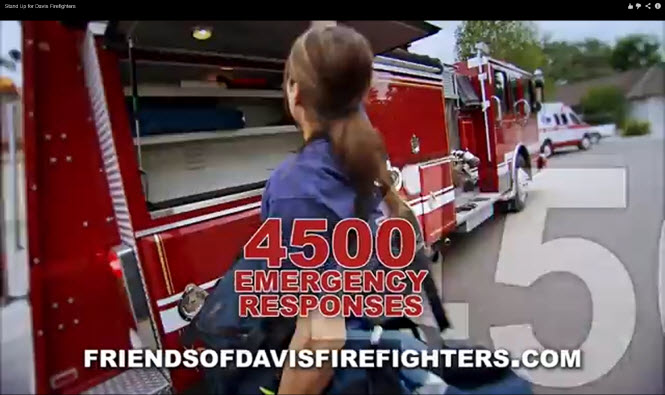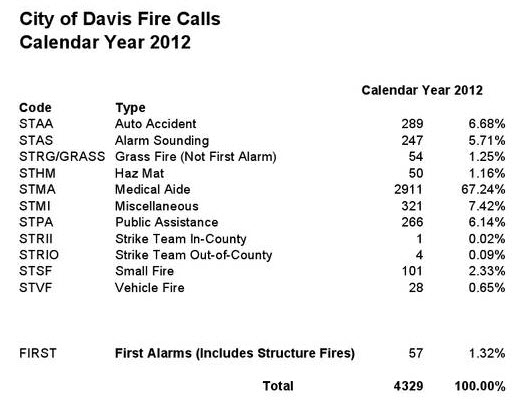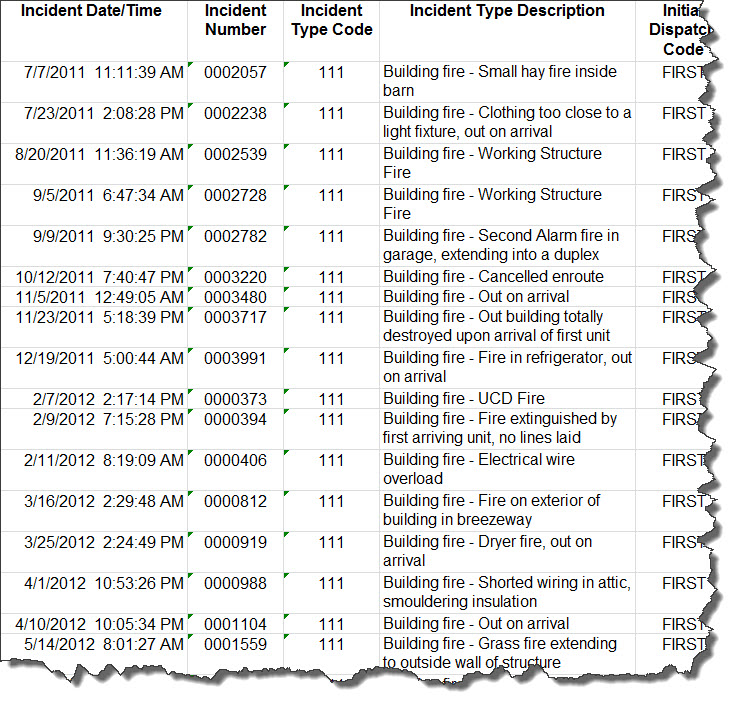
Yesterday’s article laid critical groundwork arguing for the moving of the central fire station, north from its current location on Fifth Street to Covell Blvd., to take advantage of the city-UC Davis agreement to drop boundaries between the two departments.
As we showed yesterday, by enacting boundary drop, UC Davis’ fire station could serve much of the core area within a four-minute travel time. By moving the existing Davis fire station northward, it would be able to cover northern Davis, including Wildhorse Ranch, within existing response time parameters.
Furthermore, by decoupling the rescue apparatus from the fire engine in that station, the problem of simultaneous calls becomes greatly reduced.
But that is not the end of the story. To really see what is going on here, we need to look at the frequency and types of calls the city of Davis’ firefighters are receiving.

We have noted previously that by far the largest number of calls are for medical aid. Under current policy, regardless of the call, a fully-loaded fire engine with four personnel load up and arrive to handle every single emergency. Every time that is in the central area, either the west or east Davis fire stations come to the central fire station to back them up, leaving an entire area of the city uncovered.
By simply uncoupling the rescue apparatus from the fire engine at Station 31, the rescue apparatus could respond to most medical calls, leaving the fire engine with three personnel in place for the next call, avoiding the need for backfilling.
Drilling down into the additional calls, there are another 247 alarms that are sounded, which are false alarms. Another large number of calls are automobile accidents. As we reported yesterday, on every auto accident call, the Station 31 rescue vehicle responds even if the accident is not in Station 31 area.
Under current policy, that means two things. First, Engine 31 is essentially decommissioned because it is tied to the Rescue Apparatus.
Second, drilling into the data more, of the 289 auto accident calls last year, 150 of them were outside of Station 31’s area. That means, there were 150 times that Engine 31 was out of its main service area because it had to stay coupled with Station 31’s rescue apparatus.
And when that occurred, it meant that either Station 32 or Station 33 moved from their fire station to the central fire station to backfill.
According to the data, there were just 57 first alarms which would include structure fires. That represented 1.32 percent of all calls.
But this actually overstates the nature of the city’s calls for service. As the staff report this week notes, “Out of all the First Alarm calls reported, the City average during the last three fiscal years has been five to seven First Alarm calls that were actual working fires (where the building structure is actually on fire). On average, there is one working fire every two months which translates to less than 0.2 percent of all calls in a year.”
This is critical data. Drilling down into calls, most fires were small, confined to fixtures and appliances, and most were actually out on arrival. Very few, if any, would be impacted by two-in/two-out requirements.
This is a just a sampling of some of the calls to give people the flavor.

In short, we have a number of critical points that should be made.
First, the vast majority of calls are for medical service. Right now the current staffing arrangement and delivery method is inappropriate for that form of service.
Second, there are five to seven working structure fires each year, most of which are not impacted by the two-in, two-out rule.
Third, as firefighters from other jurisdictions have noted, most communities have three-person fire engines. Firefighters do not simply show up and run into the building; there is a set up time that can be performed by three people until a second unit arrives, usually two minutes later, before the original team would be ready to enter a building.
Fourth, in a case in which there are people inside the building, the two-in/two-out rule does not apply anyway.
Fifth, a division chief in an a pinch could serve as the fourth firefighter.
Sixth and more importantly, look at the crude map below.

The left side of this map, show the current configuration, without boundary drop. The fire departments are spread out linearly throughout the community. But any time the central fire station is responding to a call, one of the other fire stations has to respond also.
On the right side of the map is the proposed change where we utilize the UC Davis fire station as a fourth fire station and shift the central fire station to the north where they are better able to handle the two areas of white which are outside of the four-minute travel time.
In addition to that, the north Davis fire station in that model would have a three-person engine and a two-person rescue apparatus. The UC Davis fire station staffs three full-time firefighters on the engine and another 3 to 4 on the ladder truck.
That means that in much of the town, under this scenario, a single call would not necessitate any backfilling.
In short, for the rare big event, Davis would be better prepared to get fire personnel to an emergency and also to cover the city in the case of simultaneous calls – that would be true even with the reduction of one firefighter from the city’s staffing.
—David M. Greenwald reporting

Blogger ,
Heard through the grapevine , that your tax exempt status for this site is being investigated .
It appears that the educational and factual content are well below the benchmark needed to continue
this exempt status .
Can’t win on the facts, so have to attack on side issues i see…
David, this is really good information. I have two follow-up requests.
1) Can we see the calls by station area?
2) What is the comparable data for the current UC Davis fire station?
Looking at David’s list of 17 “fire” calls above over 1/3 of them were either cancelled or “out on arrival”…
It is my guess that the average Davis “firefighter” actually “fights” and “extinguishes” less than one fire a year…
P.S. Why does a small town like Davis (and other small towns) have stations “32 and 33” vs. just calling them stations 1, 2, and 3
P.P.S. I bet the IP address for “Avatar” is at the Fire Union HQ…
Matt:
This isn’t exactly what you want but it does show responses to out of area calls…
[img]images/stories/fire-units-outofarea.jpg[/img]
” I bet the IP address for “Avatar” is at the Fire Union HQ… “
I’m pretty sure Avatar is a retired firefighter.
I suggest the firefighters worry about more interesting things than the Vanguard’s tax exempt status.
I am not negative about your idea at all, but since it appears that if this idea goes through, many downtown calls for fire and especially medical will be covered by UCD? Will this work with only boundary drop or should there be a merger? And is there evidence (again not being negative) that the UCD expertise is equal to the DFD?
Thanks David…..
Boundary drop should be sufficient. I don’t think you’re talking a huge area even with the the shift.
SoD – Fire station numbering is done so that no two stations in Yolo County have the same number, but you’ll notice from the following list that city numbers are grouped together:
Yolo County (CA)
Yolo Fire Station Locations
Station 1 – Woodland FD
Station 2 – Woodland FD
Station 3 – Woodland FD
Station 6 – Willow Oak FPD
Station 7 – Willow Oak FPD (Wild Wings)
Station 8 – Yolo FPD
Station 9 – Knights Landing FPD
Station 11 – Zamora FPD
Station 12 – Dunnigan FPD
Station 17 – Madison FPD
Station 19 – Esparto FPD
Station 21 – Capay Valley FPD (Rumsey)
Station 22 – Capay Valley FPD (Guinda)
Station 23 – Capay Valley FPD (Brooks)
Station 25 – Yocha Dehe FD
Station 26 – Winters FD
Station 30 – West Plainfield FPD
Station 31 – Davis FD
Station 32 – Davis FD
Station 33 – Davis FD
Station 34 – UC Davis FD
Station 40 – Clarksburg FPD
Station 41 – West Sacramento FD
Station 42 – West Sacramento FD
Station 43 – West Sacramento FD
Station 44 – West Sacramento FD
Station 45 – West Sacramento FD
Station 47 – Elkhorn FPD
Station 48 – Robbins FPD (Sutter County, dispatched by Yolo)
Station 51 – Arbuckle FPD (Colusa County, dispatched by Yolo)
CDF Sonoma-Lake-Napa Unit (LNU) Brooks Station
Fire prevention, construction materials and fire codes have advanced. This has, in turn, reduced the occurrence of fire. At the same time, the cost for firefighting has increased many times the rate of inflation.
… like I have written… the absurdity of what we pay firefighters is only exceeded by the absurdity of those that defend it.
David wrote:
> I suggest the firefighters worry about more
> interesting things than the Vanguard’s tax
> exempt status.
Just a heads up, they are worried about the Vanguard (and are probably working right now to shut it down). The firefighters in California don’t make so much for so little work because they are just lucky. They are very good at taking care of their friends and stopping their enemies (with enemy defined as anyone that does not say firefighters are heroes who deserve even more pay for even less work) from saying anything negative about firefighters (out how almost all of them make more per hour and quite a few make more actual pay than the Governor of California).
Then jrberg wrote:
> SoD – Fire station numbering is done so
> that no two stations in Yolo County have
> the same number
Thanks jrberg, that makes a lot of sense…
P.S. I always see Davis firefighter pay compared to West Sac, Vacaville and Fairfield never Knights Landing, Zamora, or West Plainfield. It would be interesting to see if David can track down the average pay and total cost of employment for all the departments in Yolo County on the list above.
Frankly wrote:
> Fire prevention, construction materials and fire
> codes have advanced. This has, in turn, reduced
> the occurrence of fire. At the same time, the cost
> for firefighting has increased many times the rate
> of inflation.
It would be interesting to think outside the box and compare the cost of the city cutting back on firefighters but paying for better (louder) smoke/fire alarms, sprinklers and/or fire repair. You can rebuild one average Davis house from the ground up for less than the TCOE of two Davis firefighters…
key point is that i think david is actually putting forth a reasonable alternative. all avatar, whoever he is, can come back with is a veiled threat.
Here are the UCD Fire calls:
[img]images/stories/UCD-Fire-calls.png[/img]
That’s a relatively low number for the 7 firefighters or so they have on duty. I think they can reasonable accommodate us on boundary drop.
I fully support Davis firefighters. They do great work.
I fully support Davis firefighters. They do great work.
I fully support Davis firefighters. They do great work.
you’re completely wrong briankenyon, not only does this article have nothing to do with whether you should or should not support the firefighters, and it has little to do with whether or not they are doing great work, it has to do with whether the staffing is appropriate for their workload – BUT, they don’t do great work. what david’s article showed yesterday is that at least at the top, they put the issue of a fourth fire station ahead of the public’s safety. by it’s very nature, that is not doing “great work.”